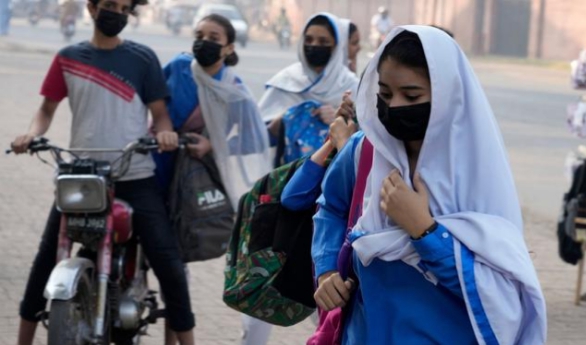By Adeyemi Adekunle
Pakistani authorities have taken the unprecedented step of closing primary schools for a week in Lahore, the nation’s cultural capital, amid alarming levels of air pollution. This decision, announced by government officials over the weekend, comes as the city’s air quality index reached record highs, raising serious alarms regarding the health and safety of its youngest residents.
As toxic haze envelops Lahore, the government’s measures reflect a swift response aimed at safeguarding children’s well-being. The decision to temporarily halt primary education reflects the urgency of the situation; children, particularly those with respiratory issues, are at heightened risk in such deplorable air conditions. Authorities emphasized that the closures are part of a wider strategy to combat respiratory-related illnesses and other health complications arising from the hazardous environment.
“The health of our children is our top priority,” stated a government spokesperson. “We cannot ignore the immediate impact of this pollution on their respiratory health. The closure of schools is a necessary and proactive measure.”
Also all citizens of Lahore have been mandated to wear face masks when venturing outdoors, a precautionary step aimed at reducing exposure to harmful pollutants. The government’s announcement outlined a series of accompanying measures, notably a “green lockdown” that restricts 50% of employees from reporting to work in person.
This initiative is intended to minimize the number of vehicles on the road and, consequently, decrease emissions that contribute to the city’s deteriorating air quality.
The authorities have also implemented several specific restrictions as part of the lockdown. Barbecuing food without filters has been banned, and motorized rickshaws will face limitations in their operation. Wedding halls, which have previously been venues for large gatherings, must now close their doors by 10 p.m. to further reduce air pollution stemming from increased traffic and festivities.
In an innovative yet controversial move, the government has proposed the possibility of utilizing artificial rain to counteract the smog that has blanketed the city. The use of cloud seeding technology, while not yet fully realized in the region, indicates the lengths to which officials are willing to go in order to address this pressing crisis.
Local residents have reacted with a mixture of concern and frustration. Many express understanding of the necessity for immediate intervention, while others voice skepticism regarding the effectiveness of these sudden restrictions. “I appreciate that they are trying to protect our kids, but we need long-term solutions, not just temporary band-aids,” said Aisha Khan, a resident of Lahore and mother of two school-aged children.
The environmental crisis is not new for Lahore, which has repeatedly faced challenges posed by the annual winter smog season, largely driven by weather conditions and agricultural burning in surrounding areas. However, this year’s spike in pollution levels is particularly severe, prompting widespread media coverage and discussions across social platforms regarding health ramifications and government accountability.
Advocacy groups are calling for a coordinated response that extends beyond immediate measures. “We need to tackle the root causes of air pollution,” urged Farhan Malik, an environmental activist. “This includes investing in sustainable public transport, stricter regulations on industrial emissions, and promoting clean energy sources. These short-term fixes will not resolve the ongoing crisis.”
As Lahore grapples with the consequences of its air quality crisis, the local health system is bracing for increased cases of respiratory illnesses, especially among vulnerable populations. Hospitals are on alert, preparing to handle the rise in patients suffering from smog-related conditions.
The alarming air quality situation in Lahore serves as a stark reminder of the broader environmental challenges facing urban centers across Pakistan.
As the nation navigates its complex relationship with industrial growth and environmental stewardship, the urgent need for effective policies and community awareness has never been clearer.
In a city known for its rich culture and vibrant history, the current air quality crisis poses a significant threat not only to public health but also to the quality of life of its inhabitants.




